
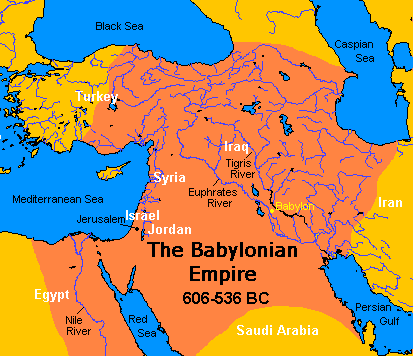


While related, Babylonia and Babylon are not the same. Babylon was a city, while Babylonia was the broader region or state centered around that city, according to eHRAF World Cultures.
�Babylon was a key kingdom in ancient Mesopotamia. The city was built upon the Euphrates river and divided in equal parts along its left and right banks, with steep embankments to contain the river's seasonal floods. Babylon was originally a small Akkadian city dating from the period of the Akkadian Empire c. 2300 BC.
The town became an independent city-state with the rise of the First Amorite Babylonian Dynasty in the nineteenth century BC. After the Amorite king Hammurabi created a short-lived empire in the 18th century BC, southern Mesopotamia became known as Babylonia and Babylon eclipsed Nippur as its "holy city". The empire waned under Hammurabi's son Samsu-iluna and Babylon spent long periods under Assyrian, Kassite and Elamite domination. After being destroyed and then rebuilt by the Assyrians, Babylon became the capital of the Neo-Babylonian Empire from 609 to 539 BC. The Hanging Gardens of Babylon was one of the Seven Wonders of the Ancient World. After the fall of the Neo-Babylonian Empire, the city came under the rule of the Achaemenid, Seleucid, Parthian, Roman, and Sassanid empires.
It has been estimated that Babylon was the largest city in the world from c. 1770 to 1670 BC, and again between c. 612 and 320 BC. It was perhaps the first city to reach a population above 200,000. Estimates for the maximum extent of its area range from 890 to 900 hectares (2,200 acres). The remains of the city are in present-day Hillah, Babil Governorate, Iraq, about 85 kilometres (53 mi) south of Baghdad, comprising a large tell of broken mud-brick buildings and debris.
The main sources of information about Babylon - excavation of the site itself, references in cuneiform texts found elsewhere in Mesopotamia, references in the Bible, descriptions in classical writing (especially by Herodotus), and second-hand descriptions (citing the work of Ctesias and Berossus) - present an incomplete and sometimes contradictory picture of the ancient city even at its peak in the sixth century.
Babylonian Map of the World ("Imago Mundi" in Latin)
Babylonian Map of the World: The oldest known map of the ancient world Live Science - September 9, 2024
The ancient clay table offers a glimpse of how the Babylonians viewed the world thousands of years ago. It is from: Abu Habba (Sippar), an ancient Babylonian city in what is now Iraq. This tablet is peppered with details that offer insight into an earlier time. For example, the ancient world is shown as a singular disc, which is encircled by a ring of water called the Bitter River. At the world's center sits the Euphrates River and the ancient Mesopotamian city of Babylon. Labels written in cuneiform, an ancient text, note each location on the map, according to The British Museum.
Babylonian Tablet Holds Oldest Evidence of Trigonometry
Live Science - August 24, 2017
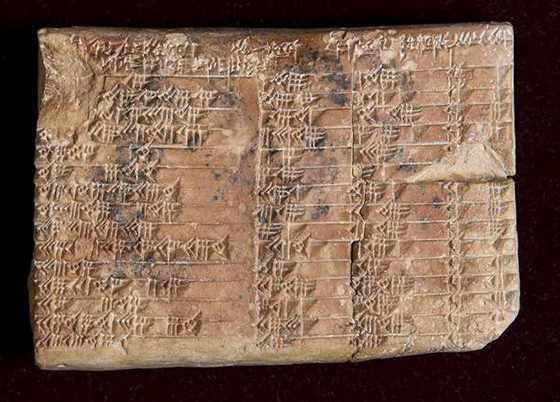
Mathematical mystery of ancient Babylonian clay tablet solved PhysOrg - August 24, 2017
UNSW Sydney scientists have discovered the purpose of a famous 3700-year old Babylonian clay tablet, revealing it is the world's oldest and most accurate trigonometric table, possibly used by ancient mathematical scribes to calculate how to construct palaces and temples and build canals.
The new research shows the Babylonians beat the Greeks to the invention of trigonometry - the study of triangles - by more than 1000 years, and reveals an ancient mathematical sophistication that had been hidden until now. Known as Plimpton 322, the small tablet was discovered in the early 1900s in what is now southern Iraq by archaeologist, academic, diplomat and antiquities dealer Edgar Banks, the person on whom the fictional character Indiana Jones was based. It has four columns and 15 rows of numbers written on it in the cuneiform script of the time using a base 60, or sexagesimal, system.
The earliest mention of Babylon is in a dated tablet of the reign of Sargon of Akkad (24th century BC short chr.), who made it the capital of his empire. Over the years its power and population waned. From around the 20th century BC, it was occupied by Amorites (nomadic Semitic tribes), flooding southern Mesopotamia from the the west, until it became the capital of Hammurabi's empire (ca. 18th century BC). From that time onward, it continued to be the capital of Babylonia, though during the 440 years of domination by the Kassites (1595-1155 BC), the city was renamed "Karanduniash".
The city itself was built upon the Euphrates, and divided in equal parts along its left and right banks with steep embankments to contain the river's seasonal floods. Babylon grew in extent and grandeur over time, but gradually became subject to the rule of Assyria.
During the reign of Sennacherib of Assyria, Babylonia was in a constant state of revolt, led by Mushezib-Marduk, and suppressed only by the complete destruction of the city of Babylon.
In 689 BC, its walls, temples and palaces were razed to the ground, and the rubbish thrown into the Arakhtu, the canal bordering the earlier Babylon on the south. This act shocked the religious conscience of Mesopotamia; the subsequent murder of Sennacherib was held to be in expiation of it, and his successor Esarhaddon hastened to rebuild the old city, to receive there his crown, and make it his residence during part of the year. On his death, Babylonia was left to his elder son Shamash-shum-ukin, who eventually headed a revolt against his brother Assurbanipal.
Once again, Babylon was besieged by the Assyrians and starved into surrender. Assurbanipal purified the city and celebrated a "service of reconciliation", but did not venture to "take the hands" of Bel. In the subsequent overthrow of the Assyrian empire, the Babylonians saw another example of divine vengeance.
On the fall of Nineveh (612 BC), Babylon threw off the Assyrian yoke, and became the capital of the Neo-Babylonian empire. Egypt had had a very large cultural influence prior to this, until the Babylonians defeated the Egyptians at the Battle of Carchemish and thus removed them as a major world empire.
With the recovery of Babylonian independence under Nabopolassar a new era of architectural activity ensued, and his son Nebuchadrezzar II made Babylon into one of the wonders of the ancient world.
Beautification of Babylon by Nebuchadrezzar II
It was under the rule of king Nebuchadrezzar II (605 BC-562 BC) that Babylon became one of the most splendid cities of the ancient world. Nebuchadrezzar ordered the complete reconstruction of the imperial grounds, including rebuilding the Etemenanki ziggurat and the construction of the Ishtar Gate -- the most spectacular of eight gates that ringed the perimeter of Babylon.
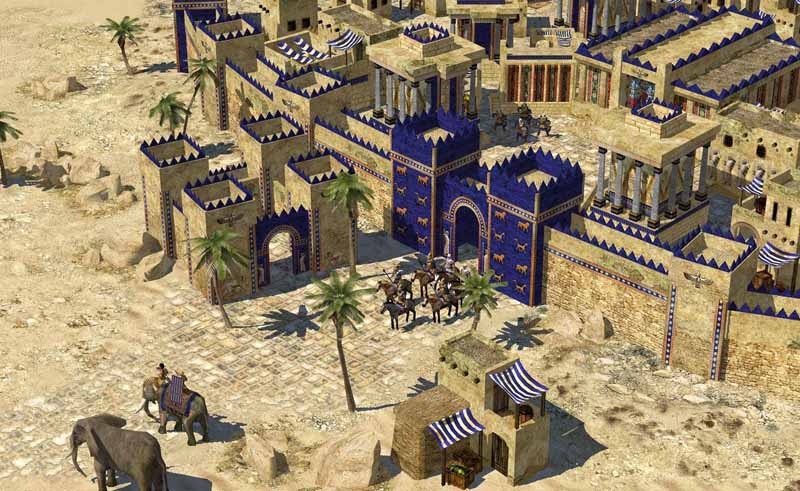
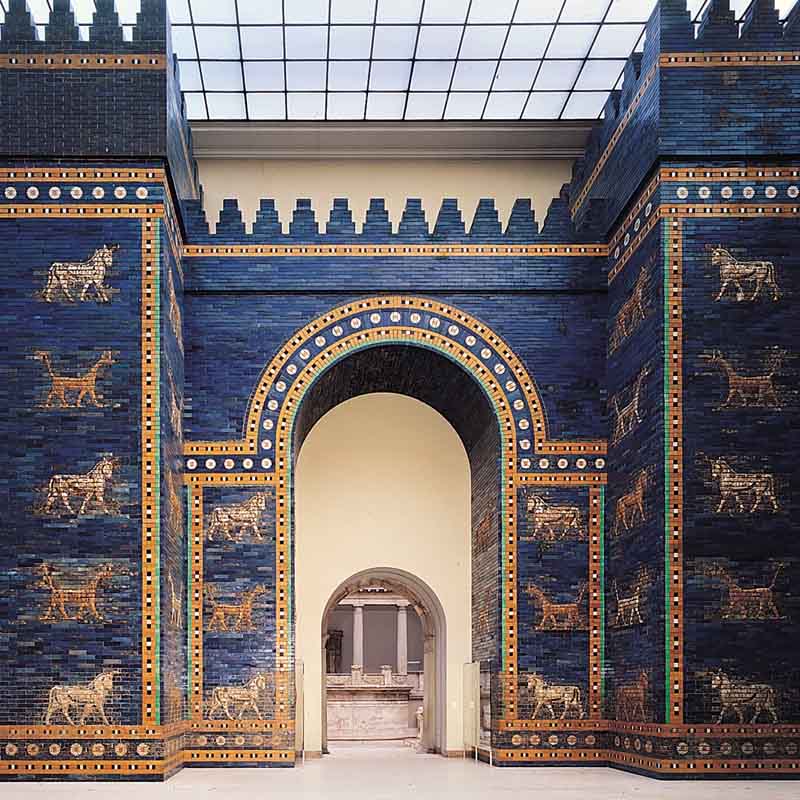
The Ishtar Gate survives today in the Pergamon Museum in Berlin.

The Tower of Babel has often been associated with known structures, notably the Etemenanki, a ziggurat dedicated to Marduk by Nabopolassar (c. 610 BC). The Great Ziggurat of Babylon base was square (not round), 91 metres (300 ft) in height, but demolished by Alexander the Great. A Sumerian story with some similar elements is preserved in Enmerkar and the Lord of Aratta.
Etemenanki - "temple of the foundation of heaven and earth" - was the name of a ziggurat dedicated to Marduk in the city of Babylon of the 6th century BCE Neo-Babylonian dynasty. Originally seven stories in height, little remains of it now except ruins.
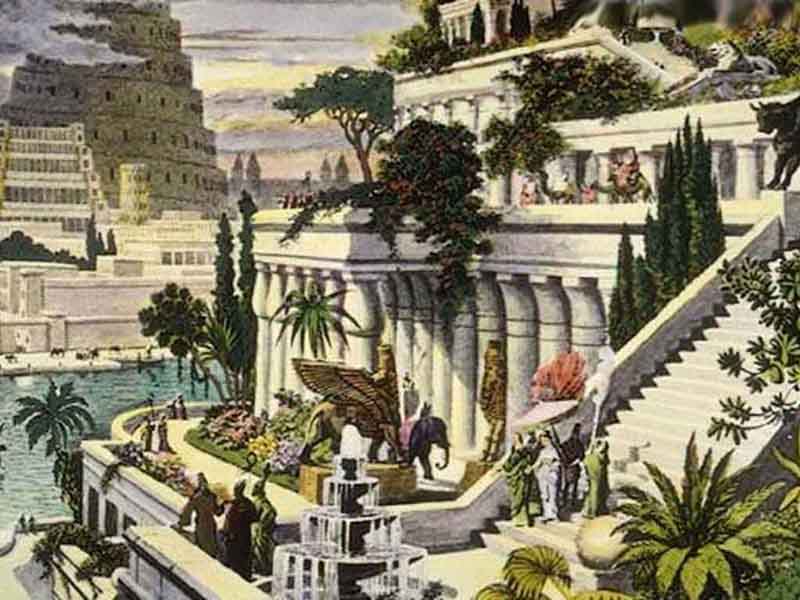
Nebuchadrezzar is also credited with the construction of the Hanging Gardens of Babylon - one of the seven wonders of the ancient world, said to have been built for his homesick wife Amyitis. Whether the gardens did exist is a matter of dispute. Although excavations by German archaeologist Robert Koldewey are thought to reveal its foundations, many historians disagree about the location, and some believe it may have been confused with gardens in Nineveh.
After passing through various vicissitudes, the city was occupied in 538 BC by Cyrus the Great, king of Persia, who issued a decree permitting the Jews to return to their own land (Ezra 1). Under Cyrus and his heir Darius I, Babylon became a center of learning and scientific advancement. Babylonian scholars completed maps of constellations, and created the foundations of modern astronomy and mathematics. However, during the reign of Darius III, Babylon began to stagnate and degenerate.
In 331 BC, Darius III was defeated by the forces of the Macedonian ruler Alexander the Great at the battle of Gaugamela, and in October, Babylon saw its own invasion and occupation. A native account of this invasion notes a ruling by Alexander not to enter the homes of its inhabitants.
Under Alexander, Babylon again flourished as a center of learning and commerce. But following Alexander's mysterious death in 323 BC in the palace of Nebuchadrezzar, his empire was divided amongst his generals, and decades of fighting soon began, with Babylon once again caught in the middle.The constant turmoil virtually emptied the city of Babylon.
A tablet dated 275 BC states that the inhabitants of Babylon were transported to Seleucia, where a palace was built, as well as a temple given the ancient name of E-Saggila. With this deportation, the history of Babylon comes practically to an end, though more than a century later, it was found that sacrifices were still performed in its old sanctuary.
By 141 BC, when the Parthian Empire took over the region, Babylon was in complete desolation and obscurity.

Babylon (Iraq) was once an ancient wonder. Today Babylon rests in a delicate balance between grandeur and decay (View 15 Photos) CNN- September 19, 2025
Once, Babylon was the jewel of Mesopotamia, the city that gave its name to entire eras - the Old, Middle, and New Babylonian periods. It was here that Nebuchadnezzar II ruled, where colossal temples and palaces were built, and where poets and chroniclers imagined one of the Seven Wonders of the Ancient World: the Hanging Gardens. Today, inscribed as a UNESCO World Heritage Site yet still at risk, Babylon rests in a delicate balance between grandeur and decay.
To walk through Babylon is to walk through layers of myth and memory. The first sight greeting many visitors is the reconstructed Ishtar Gate, its deep blue surface once adorned with lions and dragons in golden relief. Beyond it stretches the Processional Way, a ceremonial road once used for royal festivals like the Akitu New Year - said to be one of the world's oldest celebrations.
Here, Nebuchadnezzar II, who reigned from 605 to 562 BCE, stamped his mark on history. He built palaces and temples of staggering scale, expanded the city's defenses, and left inscriptions that still proclaim his power. The massive Etemenanki ziggurat - believed by some to have inspired the biblical Tower of Babel - once dominated the skyline.
And then there are the Hanging Gardens. Ancient Greek and Roman writers described them as a lush paradise of terraced greenery, watered by ingenious pumps that lifted water from the Euphrates. According to legend, Nebuchadnezzar commissioned them for his queen, Amytis, who longed for the forested mountains of her homeland.
Historical knowledge of Babylon's topography is derived from classical writers, the inscriptions of Nebuchadrezzar, and several excavations, including those of the Deutsche Orientgesellschaft begun in 1899. The layout is that of the Babylon of Nebuchadrezzar; the older Babylon destroyed by Sennacherib having left few, if any, traces behind.
Most of the existing remains lie on the east bank of the Euphrates, the principal ones being three vast mounds: the Babil to the north, the Qasr or "Palace" (also known as the Mujelliba) in the centre, and the Ishgn "Amran ibn" All, with the outlying spur of the Jumjuma, to the south. East of these come the Ishgn el-Aswad or "Black Mound" and three lines of rampart, one of which encloses the Babil mound on the N. and E. sides, while a third forms a triangle with the S.E. angle of the other two. West of the Euphrates are other ramparts, and the remains of the ancient Borsippa.
Saddam Hussein installed a huge portrait of himself and Nebuchadrezzar at the entrance to the ruins. He also had part of the ruins rebuilt, to the dismay of archaeologists, with his name inscribed on many of the bricks, in imitation of Nebuchadrezzar. One frequent inscription reads: "This was built by Saddam Hussein, son of Nebuchadnezzar, to glorify Iraq".
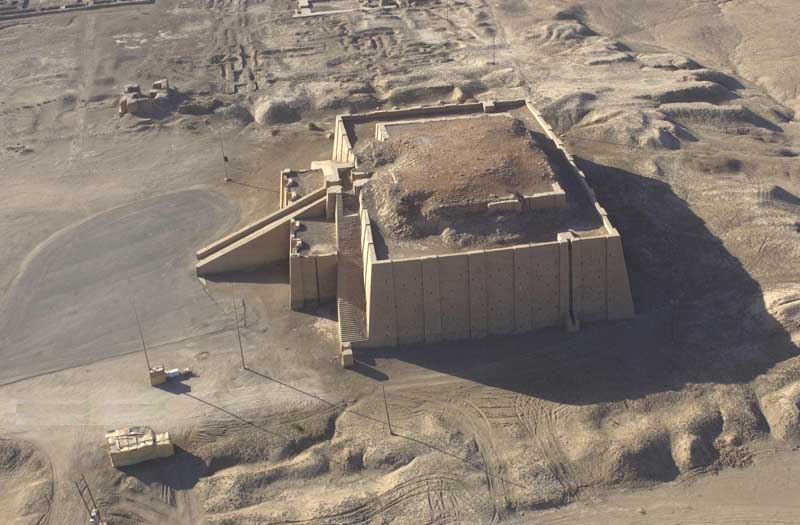
This recalls the ziggurat at Ur, where each individual brick was stamped with "Ur-Nammu, king of Ur, who built the temple of Nanna". These bricks became sought after as collectors' items after the downfall of Saddam, and the ruins are no longer being restored to their original state.
Babel is the name used in the Hebrew Bible for the city of Babylon. It means "gate of the god", corresponding to the Akkadian Bab-ili. According to Genesis 11:1-9, mankind, after the deluge, traveled from the mountain of the East, where the ark had rested, and settled in 'a plain in the land of Shinar' (or Sennar). Here, they attempted to build a city and a tower whose top might reach unto Heaven - the Tower of Babel - but God miraculously confounded the languages of those who were working at its building so that they could not understand each other, and the project failed.
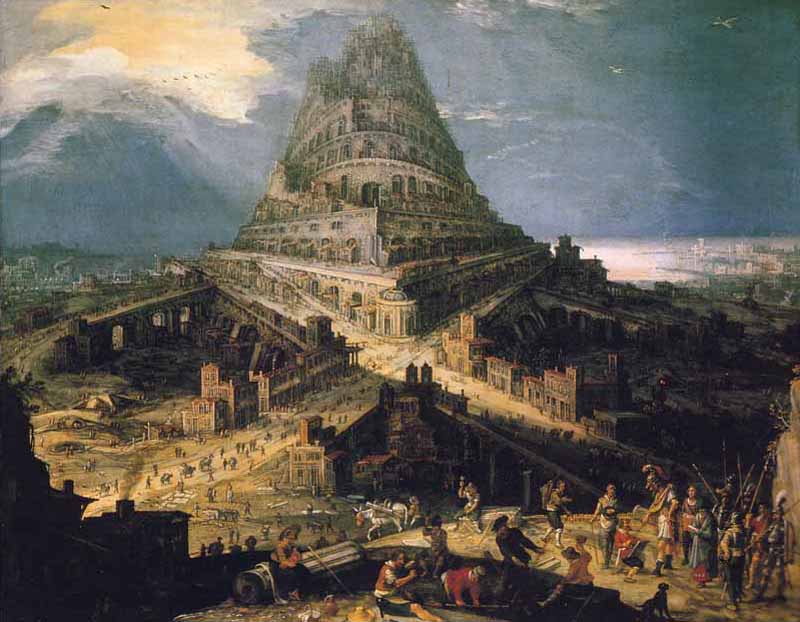
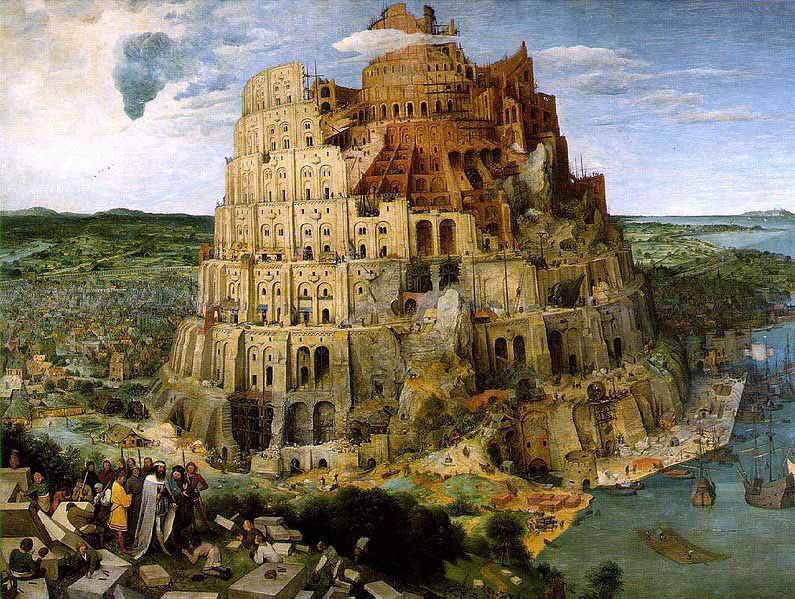
Tower of Babel by Pieter Bruegel the Elder (1563)
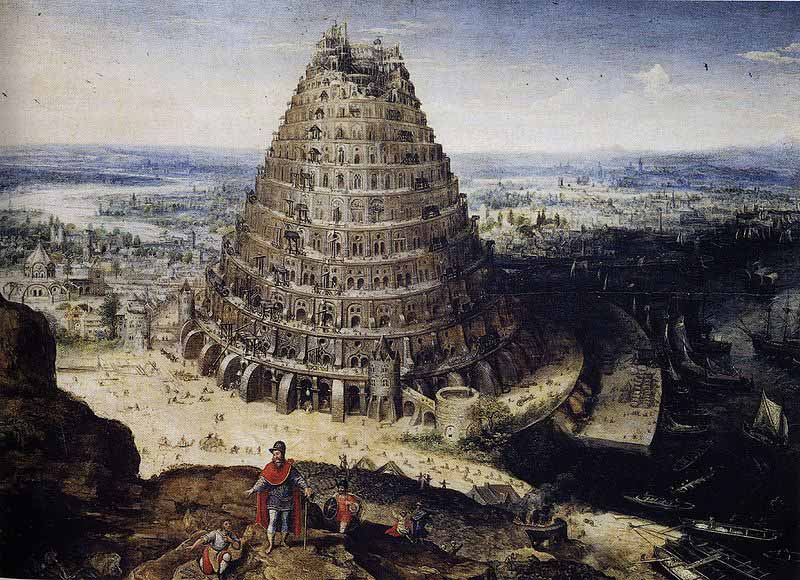
Tower of Babel by Lucas van Valckenborch
In this classic story from the Old Testament of the Bible, the people of the Earth were building a colossal staged temple-tower or multi-storied ziggurat that would reach heaven and used it as a place of worship. The Tower of Babel, according to the Book of Genesis, was an enormous tower built in the plain of Shinar.
The phrase "The Tower of Babel" does not actually appear in the Bible; it is always, "the city and its tower".
According to the biblical account, a united humanity of the generations following the Great Flood, speaking a single language and migrating from the east, came to the land of Shinar, where they resolved to build a city with a tower "with its top in the heavens ... lest we be scattered abroad upon the face of the Earth." God came down to see what they did and said: "They are one people and have one language, and nothing will be with holding from them which they purpose to do." So God said, "Come, let us go down and confound their speech." And so God scattered them upon the face of the Earth, and confused their languages, and they left off building the city, which was called Babel "because God there confounded the language of all the Earth."(Genesis 11:5-8). Read more ...

Hymn to Babylon, missing for a millennium, has been discovered PhysOrg - July 1, 2025
It's a fascinating hymn that describes Babylon in all its majesty and gives insights into the lives of its inhabitants, male and female. Babylon was founded in Mesopotamia around 2000 BCE. Once the largest city in the world, it was a cultural metropolis in which works were written that form part of our global literary heritage today.
Babylonian texts were composed in cuneiform writing on clay tablets, which have survived only in fragments. One of the goals of the collaboration with the University of Baghdad is to decipher hundreds of cuneiform tablets from the famous Sippar Library and preserve them for posterity. Legend has it that Noah hid them here from the floodwaters before boarding the ark.